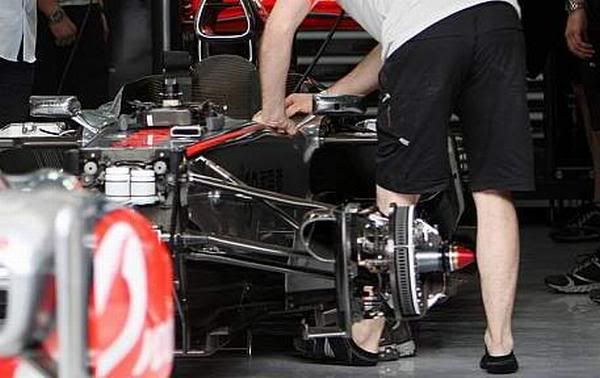From the photos I've seen to this point, this isn't completely analogous to the McLaren system. The Mac system feeds the upper element, and blows air outward, from a curved, angled slot on the upper element, the kind of thing that would create vortices (vgj's or vortex generating jets). At high speed this means less drag, less downforce than uncontrolled separation.

The Sauber solution appears at first sight to just be a logical development of the old blown wing we've seen in previous seasons (BMW, Mac). A blown wing, blowing air transversely along the surface. Now, instead of just an opening in front of the wing (passive) there is a whole system dedicated to controlling the pressure coming from that main element blowing slot. Question is, does it increase or decrease that pressure, or is it both.

But according to Autosport, there is also a slot cut into the upper element???:
"It is believed that once the air is channelled through the car it is then blown out onto the main profile of the rear wing, rather than the upper element as happens with McLaren. It is not clear where the driver is able to influence the airflow.
As well as the duct, Sauber has introduced a slot gap in the middle of the upper element - in similar style to the McLaren design that was approved by the FIA."
Question is, does the fin actually feed a slot on the upper element as well? The pics I've seen don't indicate this. The research I've done suggests there are tons of things you could do with a tube of air running to or from a wing. Question is, what have Sauber decided to do with theirs. Need more pics!
Oh, even if the supposed upper element slot isn't fed, it could still have an effect on flow:
"Surface static pressure measurements and oil-flow visualization results from the wind tunnel tests indicated that
transverse grooves, longitudinal grooves, submerged vortex generators,
vortex generator jets (VGJ's), Viets' fluidic flappers, elongated arches at (+)alpha (positive angle of attack), and large-eddy breakup devices (LEBUS's) at (+)alpha placed near the baseline separation location reduce flow separation and increase pressure recovery."
http://adsabs.harvard.edu/abs/1992PhDT........50L
Kelpster
edit: bolded wrong term









